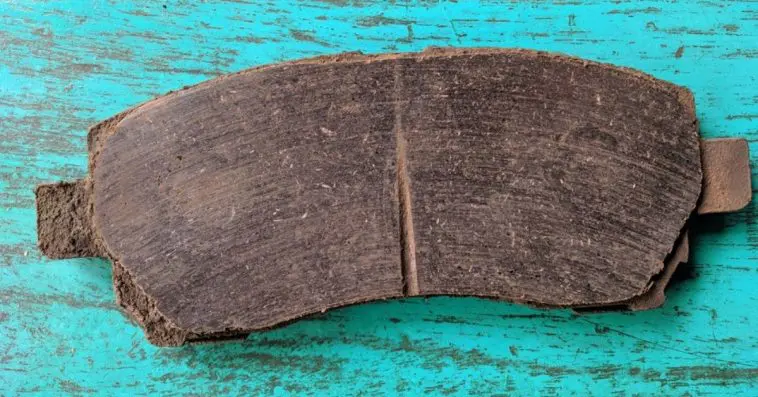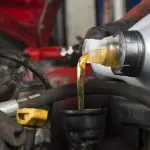The brake pads of various cars are manufactured from different materials and each has an advantage over the other.
This makes one particular type of brake pad suitable for use in one model of a car and maybe not that suitable in another car.
You should ensure that the brake pad you have installed in your car braking system is ideal as it will be needed to be at its best performance and it should also be highly durable.
Do you know what brake pads are made of? Brake pads are made of either ceramic, semi-metallic or metallic components as these are the most common materials used in the manufacture of brake pads. They are also the top-performing ones in various brands of cars.
You can choose from the different types of brake pads at your disposal to choose an ideal one.
This will guarantee the safety of your car as well as of that of the passengers in the same car.
You should also know that brake pads in poor condition also damages the other parts of the disc brake system.
TABLE OF CONTENTS
Brake Pads Material
1. Semi-Metallic Brake Pads
These are used in brake pads and are usually designed with metal shavings of either copper, steel, graphite or brass resin.
They heaven found to be ideal for car models that are used one daily basis on the roads under normal conditions.
They might also be found to be useful for heavy-duty trucks and those that are heavily loaded as they can provide high braking power when needed.
2. Organic Brake Pads
These are usually manufactured from non-metallic parts such as glass, rubber and Kevlar bonded resin.
They are much softer than their alternatives and have been found to provide the best performance under high-temperature conditions.
This is because the heat is good for their structural bonding. The asbestos brake pads were a type of the organic brake pads, but they were abolished to their harmful effects on the living organisms.
3. Ceramic Brake Pads
These are designed to comprise mainly of ceramic fibers. They might also include some other filling materials that are bonded together to the best out of these brake pads.
They have been considered to be the best brake pads you can get unless you want one for a race car.
Their popularity is simply because of their top performance and also because they are clean as they do not encourage too much dust build-up.
Similarly, they are a user favorite because of the high durability and also because of the fact that they make less noise than their competition.
Ceramic Vs. Semi-Metallic Brake Pads: Which One Is Better?
There are different materials used to manufacture brake pads, you can either go for ceramic or semi-metallic brake pads.
The two are analyzed in the following ways:
1. Ceramic Brake Pads
Ceramic brake pads have been in existence for not less than forty years now, and have been one of the top brake pads to ever be used on motor vehicles.
These are designed using a blend of super-strong ceramic and copper fibers that are embedded upon the particular brake pad.
This gives these types of brake pads the ability to withstand the harshest conditions.
Pros
- Do not make as much noise as most other types of brake pads
- Associated with less dust thus cleaner than alternatives
- Highly durable when compared to the semi-metallic brands
Cons
- Quite costly
- Subject the brake rotors to more damage than in the case of the semi-metallic ones
- Not a good type for racing cars or those used in the towing capacity
2. Semi-Metallic Brake Pads
The semi-metallic brake pads are designed with parts of metallic fibers that are included in the brake compound.
High-quality types are advanced and have fine metallic fibers while the lower quality ones are designed with larger and rougher portions of metal.
Pros
- Provide effective grip even in cold temperatures
- Great for the cold conditions and driving in short trips
- Quite affordable when compared to the ceramic brake pads
- Do not exert more friction on the brake rotors
- Can be used for cars utilized for heavy towing
Cons
- Make a lot of noise unlike the ceramic brake pads
- Not as durable as the ceramic alternatives
- Dirtier than the ceramic brake pads due to the dust created
As seen from the above discussions, the ceramic type of brake pads is the best when it comes to performance.
This is because of its effective workability and also due to the fact that it creates less dust, is cleaner and is more durable.
However, if you are on a tight budget, they might not be the best option to go for. They are also not the best to be used for racing cars.
The semi-metallic type is the one you should go for if you do not have a lot to spend or even if you want to use it in a car utilized for heavy towing.
What Are Brembo Brake Pads Made Of?
The brumby brake pads are manufactured from a blend of compounds which include organic resins, sintered and carbon-ceramic pads.
The fact that they are made from ceramic makes them a good option to go for if you are looking for long-lasting brake pads.
This article explains how long do brake pads usually last.
They also provide high-quality performance and are quite comfortable to use in any car.
Where Are Brembo Brake Pads Made At?
The Brembo brake pads are manufactured in Italy.
Brembo S.p.A is actually a manufacturer situated in Italy and works on manufacturing brake systems for various automotive such as cars and motorcycles.
What Are Toyota Brake Pads Made Of?
The Toyota brake pads are manufactured from OEM. The OEM manufactured brake pads provide a good option for cars that are driven in normal driving conditions.
This is because of their high-quality performance when it comes to cold temperatures and that they are also long-lasting.
You will also realize that they do not make as much noise as some alternative brake pads.
What Are BMW Brake Pads Made Of?
The brake pads in BMW pads can either be made from metallic components. This is because the BMW brake pads appear to be quite dusty.
What Are F1 Brake Pads Made Of?
The brake pads of F1 cars are manufactured from a composite material that is reinforced with carbon fiber.
Ceramic brake pads are avoided for F1 cars because they are not suitable for racing.
What Are Truck Brake Pads Made Of?
The brake pads in most trucks are made of semi-metallic components as they possess a suitable feature for working in such conditions.
They might have other types of brake pads but the semi-metallic ones are the most common.
What Are Volkswagen Brake Pads Made Of?
The brake pads of Volkswagen cars can be made out of either metallic, organic, ceramic or composite components.
Some might have been manufactured in a composite manner for ultimate performance.
What Are Volvo Brake Pads Made Of?
The brake pads in Volvo cars are made from OEM material. Some might be manufactured from other material, the rare ones but the OEM brake pads are common for the Volvo cars.
Frequently Asked Questions
You now understood what materials are used for brake pads.
Below you will learn is that many people also have in their minds about these types of questions when it comes to the main subject above. I highly suggest you keep reading!
Q1: Are Brake Pads Made Of Asbestos?
Asbestos was initially used in the manufacture of the linings of the brake pads.
They are not used generally in manufacturing various car components such as the brake pads or the clutch because the asbestos is quite harmful if inhaled by anyone close to it.
A brake pad that is manufactured from asbestos can be seen when you just take a look at it.
The bad thing with brake pads manufactured using asbestos is that it can turn out to be quite harmful.
What happens is that the asbestos breaks down into very small particles, that are even smaller than the smallest blood cell.
This then gets lodged to the internal parts of the lungs. This might later in the life of the affected, cause the development of cancer.
Asbestos is released to the air as a result of the process of the wearing out of the brake pads.
They are then released to the environment as dust, it may also get trapped in the brake housing or the clutch space.
Before working on a brake pad or any car component made from asbestos, it is advised to use a compressed air hose to blow away asbestos fibers so that you are not at risk of inhaling this substance.
Mechanics and professional that are either repairing the brakes or even the clutches should take this precaution to avoid harming themselves.
Q1-1: When Did They Stop Putting Asbestos On Brake Pads?
The production of brake pads manufactured from asbestos was stopped in the year 1993, and the use of the brake pads in cars was to stop in the year 1995.
Two years later, the asbestos brake linings were not to be stocked on the shelves of auto spare shops as well as not in use in newly manufactured cars.
This was passed as a law and implemented to prevent the inhalation of asbestos particles that can turn out to lead to a cancer diagnosis.
The people who are at high risk of developing cancer due to this are the mechanics and professionals who work on repairing or replacing worn-out brake pads.
Using a special dust mask when working on brake pads designed with asbestos lining will reduce the risk of developing cancer by an individual.
Similarly, using a compressed air hose will do the trick of getting rid of trapped asbestos particles on the brake and clutch components.
Q1-2: When Was Asbestos Used In Brake Pads?
The automotive industry mainly manufactured their brake pads using asbestos in the years of the 1920s.
These were used by almost any American automotive industry in these years. Asbestos was considered the best material to be used in the manufacture of the linings of the brake pads.
However, it was discovered that asbestos was harmful due to their ability to break down into small particles.
The particles formed were as small as the blood cells and this would enter the body quite easily.
They could then lodge on the inside of the lungs and cause cancer later on in the lives of those affected to the asbestos.
In the early 1980s the use of asbestos for manufacturing brake pads was shunned upon the realization of the effects caused.
Back then the asbestos was used in the manufacture of brake pads used in brakes of aircraft for both the civilians and the military.
They were also used for the brakes of trains and even in cranes and hoist devices.
When the asbestos is used in the manufacture of the brake pads, they are safe because they are stable as they form in large particles.
However, due to the friction caused when they are used the asbestos crumbles and this causes the formation of small particles that then escape to the atmosphere.
Some would remain trapped in the brake housings if they are unable to escape to the atmosphere.
Whenever they were disturbed, for instance, when replacing old or worn-out brake pads, the small particles may be inhaled and this is quite toxic to the affected.
Q2: What Are The Best Brake Pads Made Out Of?
The best type of brake pads generally is those manufactured from the ceramic component.
This is because of the numerous benefits it these type of brake pads has over their competition.
For instance, they have the best performance in terms of their stopping power.
They are also highly durable and this makes them a favorite as no one would want to replace brake pads each and every week.
The ceramic brake pads are also a user favorite because they do not make too much noise when in use.
Similarly, they do not cause a lot of dust build up in the surrounding areas of the brake pads and thus are cleaner than alternative brake pads.
Q3: Are Brake Pads Toxic?
Yes, they are toxic. This is because the materials used in the manufacture of brake pads tend to break into small particles when acted upon by friction.
The particles are then released to the environment and are seen to have harmful effects to both animals and plants.
Conclusion
Brake pads are manufactured from different materials such as metallic, semi-metallic or even ceramic materials.
All of these have their advantages and disadvantages and that is why different car models for use in varying conditions can get ideal brake pads installed on them.
For example, the ceramic brake pads are suitable for use in normal cars due to their high performance and also because they are durable and long lasting.
The brake pads that are to be used for any car model should be ideal for the model as well as be favourable for the model.
Otherwise, the brake pads will need to be replaced more often than normal because the type of brake pads installed is not suitable for that type of model of car.
Some materials used in the manufacture of brake pads such as asbestos has some adverse effects and thus should be avoided as they might cause cancer to the affected.
Source:
1. Toyota Parts Center – https://parts.olathetoyota.com/what-are-brake-pads-made-of




